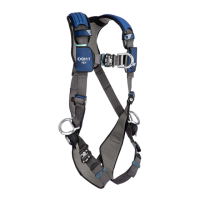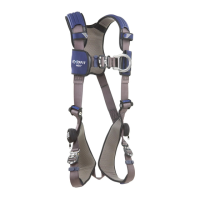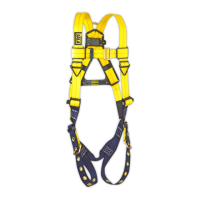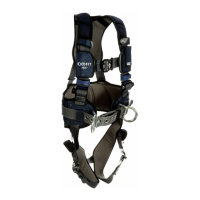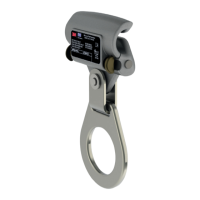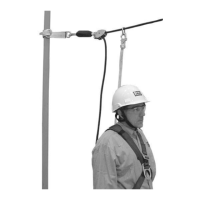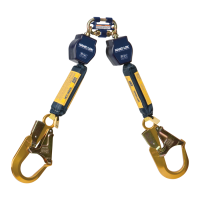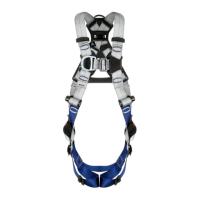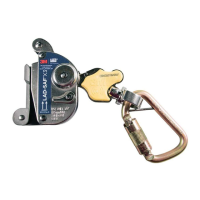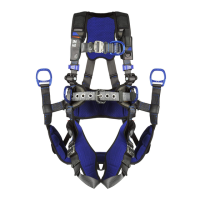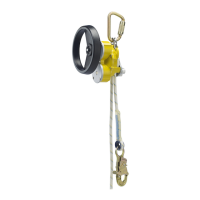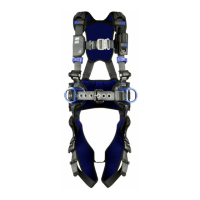19
point, the worker can move to a new location, attach the unused Lanyard Leg to another anchorage point, and then
disconnect from the original anchorage point. The sequence is repeated until the worker reaches the desired location.
See Figure 14 for Twin-Leg Lanyard 100% tie-off applications. Considerations for Twin Lanyard 100% tie-off applications
include the following:
• Never connect both Lanyard Legs to the same anchorage point (see Figure 14A).
• Connecting more than one connector into a single anchorage connection point (ring or eye) can jeopardize
compatibility of the connection due to interaction between connectors and is not recommended.
• Connection of each Lanyard Leg to a separate anchorage point is acceptable (Figure 14B).
• Each connection location must meet the Anchorage Requirements dened in Section 1.
• Never connect more than one person at a time to the Twin Leg Lanyard (Figure 14C).
• Do not allow the Lanyard Legs to become tangled or twisted together as this may prevent them from retracting.
• Do not allow Lanyard Legs to pass under arms or between legs during use.
5.0 INSPECTION
;
After equipment has been removed from service, it may not be returned to service until a Competent Person conrms in
writing that it is acceptable to do so.
5.1 INSPECTION FREQUENCY: The product shall be inspected before each use by the user and, additionally, by a
Competent Person other than the user at intervals of no longer than one year. A higher frequency of equipment use
and harsher conditions may require increasing the frequency of Competent Person inspections. The frequency of these
inspections should be determined by the Competent Person per the specic conditions of the worksite.
5.2 INSPECTION PROCEDURES: Inspect this product per the procedures listed in the “Inspection and Maintenance Log”.
Documentation of each inspection should be maintained by the owner of this equipment. An inspection and maintenance
log should be placed near the product or be otherwise easily accessible to users. It is recommended that the product is
marked with the date of next or last inspection.
5.3 DEFECTS: If the product cannot be returned to service because of an existing defect or unsafe condition, then it must be
destroyed.
5.4 PRODUCT LIFE: The functional life of the product is determined by work conditions and maintenance. As long as the
product passes inspection criteria, it may remain in service.
6.0 MAINTENANCE, SERVICE, and STORAGE
;
Equipment that is in need of maintenance or scheduled for maintenance should be tagged “DO NOT USE”. These
equipment tags should not be removed until maintenance is performed.
6.1 CLEANING: Cleaning procedures for Lanyards are as follows:
• Periodically clean the exterior of the Lanyard using water and a mild soap solution. Position the Lanyard so excess
water can drain out. Clean labels as required.
• Clean the Web Lifeline with water and mild soap solution. Rinse and thoroughly air dry. Do not force dry with heat.
The lifeline should be dry before allowing it to retract into the housing. An excessive buildup of dirt, paint, etc. may
prevent the lifeline from fully retracting back into the housing causing a potential free fall hazard.
6.2 SERVICE: Lanyards are not repairable. If the Lanyard has been subjected to fall force or if inspection reveals an unsafe or
defective condition, remove the Lanyard from service and discard.
6.3 STORAGE AND TRANSPORT: Store and transport Lanyards in a cool, dry, clean environment out of direct sunlight.
Avoid areas where chemical vapors may exist. Thoroughly inspect the Lanyard after any period of extended storage.
7.0 LABELS and MARKINGS
7.1 LABELS: Figure 20 illustrates labels present on the models covered by this instruction, as well as which labels are present
on which models. All labels must be present on any applicable models. Labels must be replaced if they are not fully
legible.
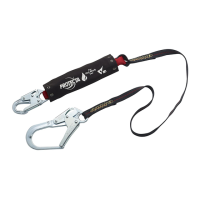
